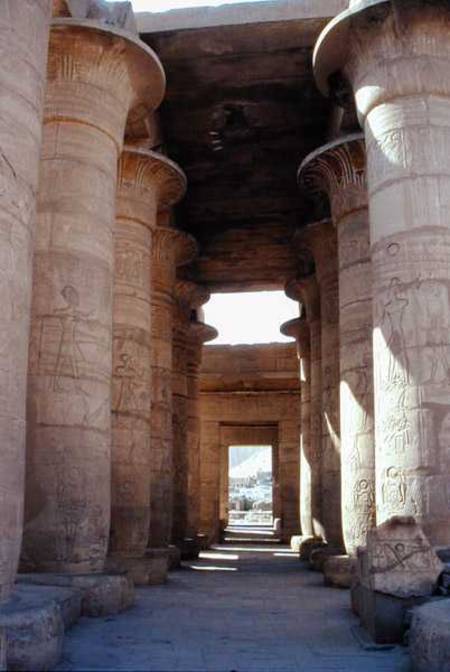To get to the creation mound in the Temple, you had to go through the Hypostyle Hall. This held much religious meaning behind it to the Egyptians. The God Amun was so important to the Egyptians, that at this particular temple, only the Chief Priest was allowed back into the room holding the mound to see the statue of the God.
I believe that the Egyptians views on their creation and the way they worshiped their Gods was really incredible. The amount of detail and time spent to create this temple alone is astonishing, especially since this temple was not a temple for the Egyptian people to go to. This temple was specifically made as a temple for the god. Only priests of Amun and Egyptian royalty were even permitted to entering the temple.
 One of many rows of columns. At one time, these were all fully painted and much more of the detail in each was prevalent.
One of many rows of columns. At one time, these were all fully painted and much more of the detail in each was prevalent. As you can see, upon passing through the main entrance, the Hypostyle Hall is the second large area you enter.
As you can see, upon passing through the main entrance, the Hypostyle Hall is the second large area you enter.Work Cited
http://www.bible-history.com/past/images/temple_of_amun_karnak9.gif
http://en.wikipedia.org/wiki/Great_Hypostyle_Hall
http://www.myartprints.co.uk/a/egyptian/columns-with-papyrus-shaf.html
This is a very interesting topic, the Egyptians offer us so much to see and discover and marvel at… it is a good blog choice. I was intrigued to find that Amun was the most important of the Egyptian Gods, and was credited to be the Creator. I had previously read that Ra was the King of the pantheon since agriculture cannot exist without the Sun, and that the Creator of all things, including the other Gods was Ptah. But this can be explained through the division of Upper and Lower Egypt, and their previous religious differences before Egypt became a united kingdom.
ReplyDeleteWhen one thinks of the word temple, it usually conjures up the idea of a place where people go to worship, but in the case of Karnak, it was a site for the God, not worshipers. This is also very interesting, as the Egyptians are considered by today’s standards to have been a very religious people, so they would no doubt have had smaller temples and shrines to Amun, but none as grand.
Your use of images is quite good, the photographs and map of the temple are helpful. It may be possible to add a video tour of the temple if there is one on YouTube. This has been a very good blog, and I look forward to its continuation. Thanks for showing me another aspect of Egyptian history and mythology that I had overlooked.